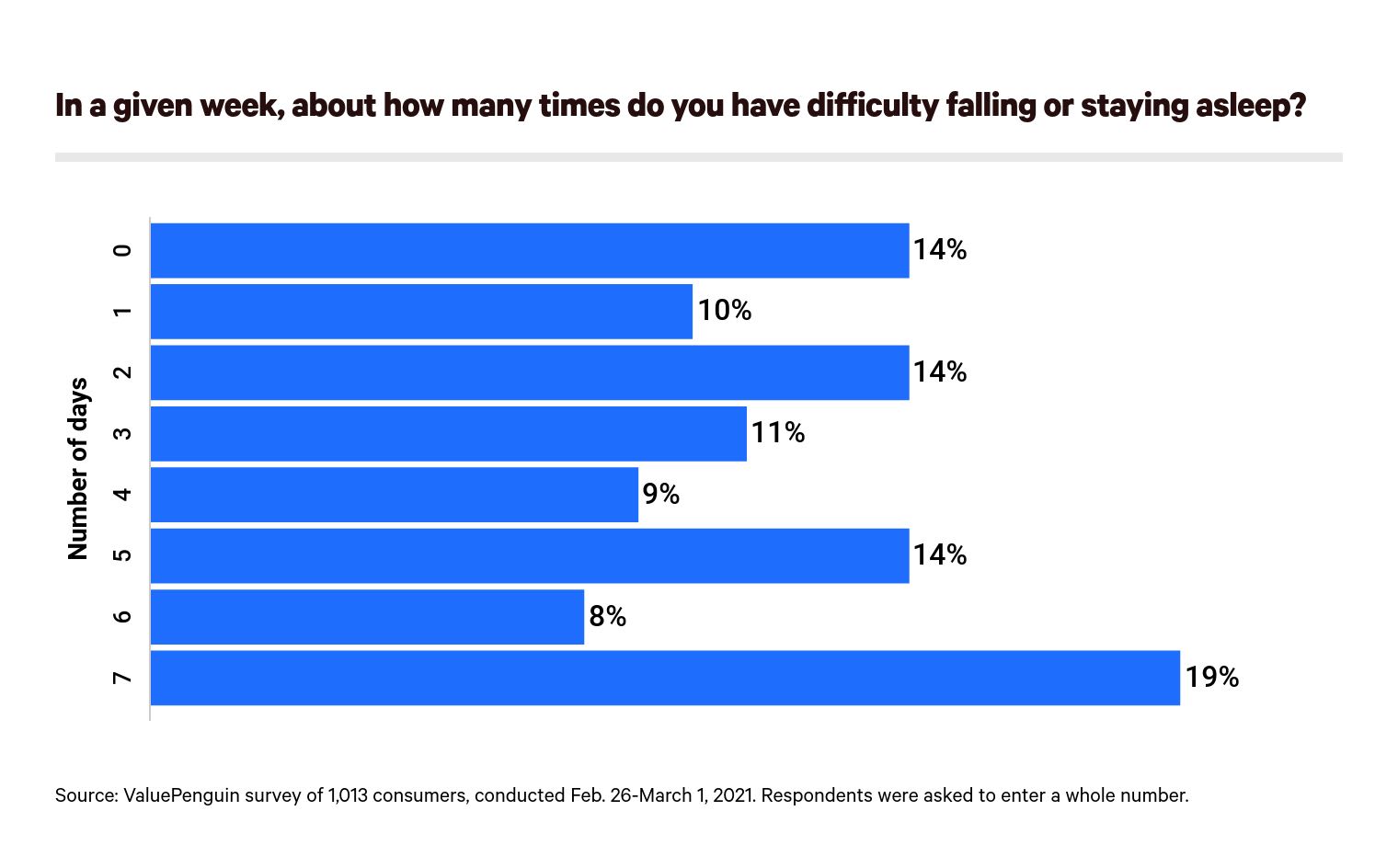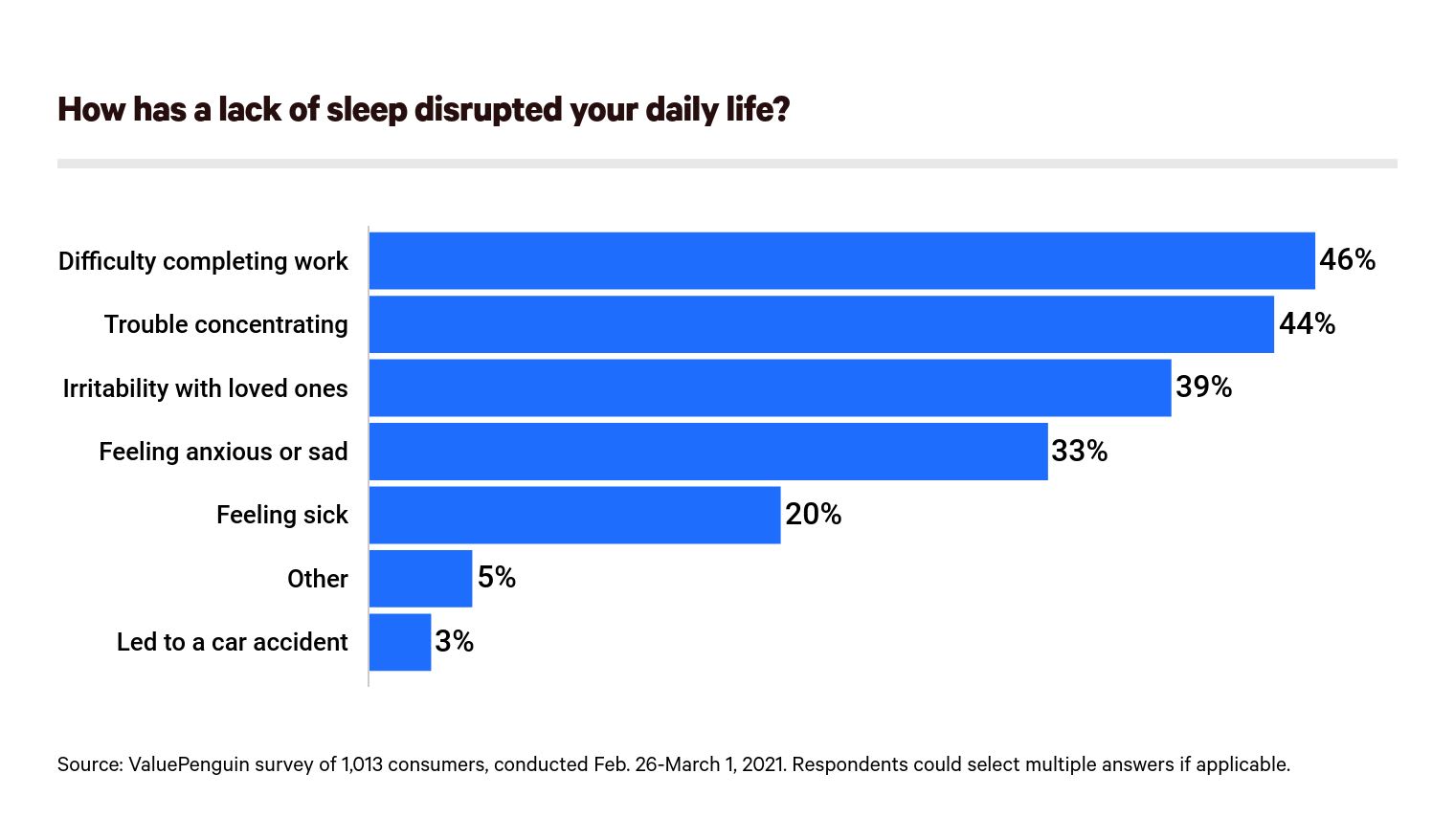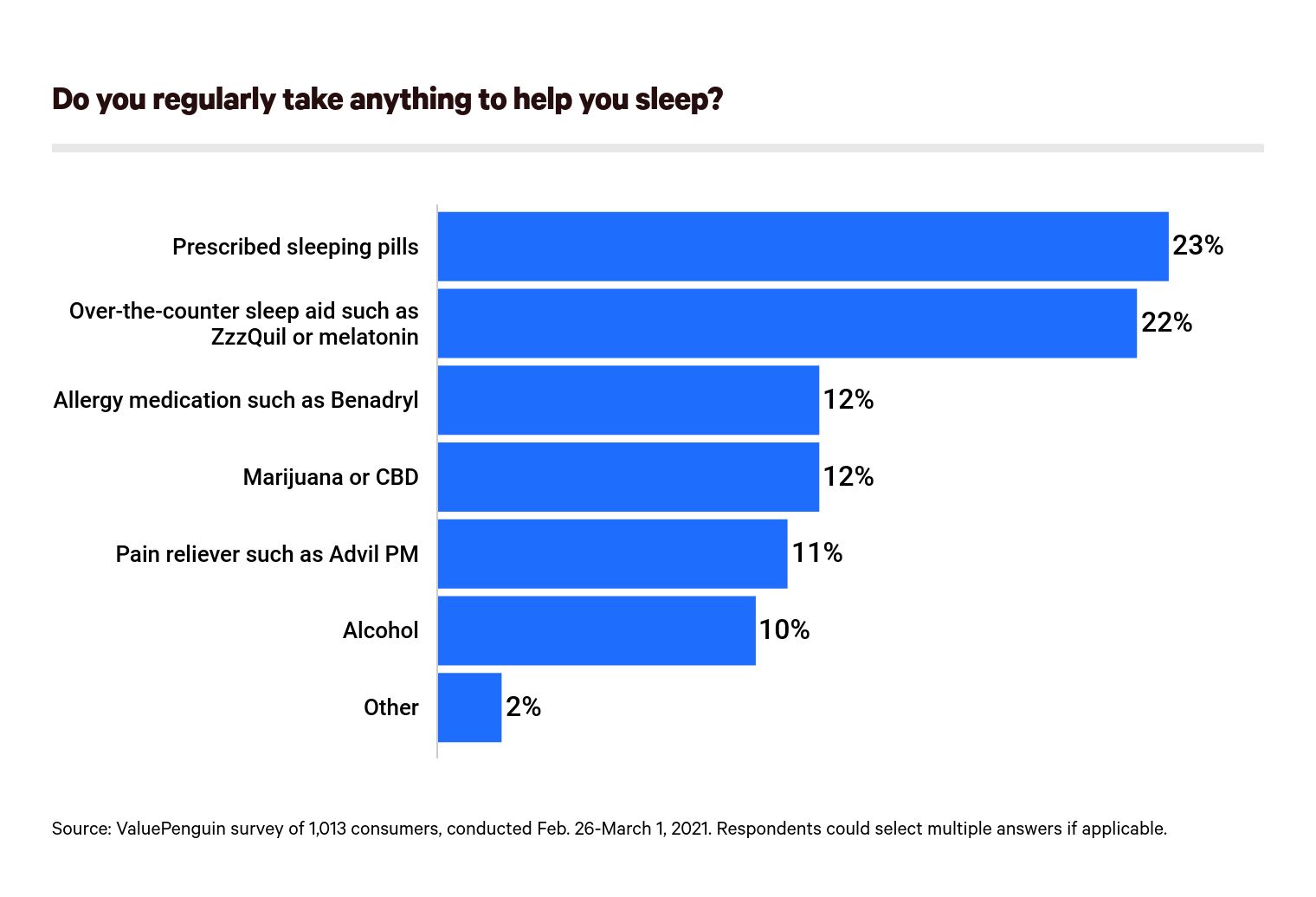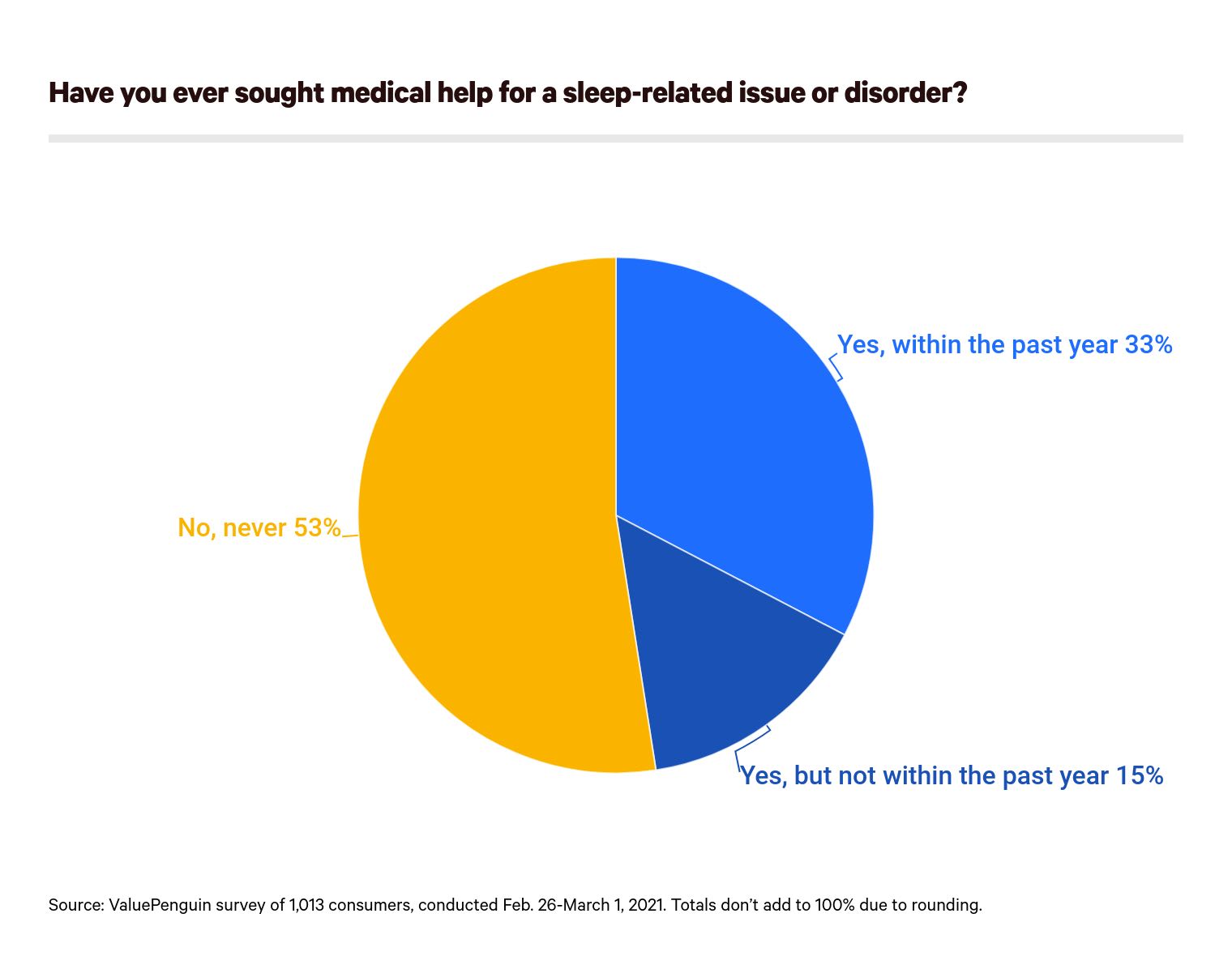Health Insurance
76% of Americans Say a Lack of Sleep in the Past Month Interrupted Daily Life, and Money Is the Top Stressor

Sleep is an essential part of everyday life and is crucial to everyday functioning. In fact, the Centers for Disease Control and Prevention (CDC) recommends that adults get a minimum of seven hours of sleep a night. However, this may not be a reality or possibility for many Americans because of factors from stress to work to sleep disorders.
A ValuePenguin survey of more than 1,000 respondents found that 86% of Americans have trouble falling or staying asleep at least once a week. According to the survey results, the average number of days a week that Americans have sleeping issues is 3.6. Here’s what else we learned.
Key findings
- Seventy-six percent of Americans say their daily life has been interrupted by a lack of sleep in the past month. Of that group, 46% say a lack of sleep led to difficulty completing work, 44% have trouble concentrating and 39% say their lack of sleep caused irritability with loved ones.
- Money is the No. 1 thing that keeps people up at night, as more than one in three are losing sleep over financial worries. That’s followed by pandemic-induced stress and family or relationship issues.
- Some consumers’ habits may be interrupting their sleep. For example, 42% of Americans drink caffeinated beverages from about 3 p.m. on, and 18% don’t get any exercise in a typical week.
- Nearly two-thirds (63%) of Americans take something to help them sleep, mainly prescribed sleeping pills (23%) or over-the-counter sleep aids (22%). But 12% use marijuana or CBD, and 10% turn to alcohol.
- Thirty-three percent of consumers have sought medical help for a sleep-related issue in the past year. Still, that means more than half have never sought medical help, even with 62% of Americans saying they suffer from some form of sleep-related condition such as insomnia or snoring.
Nearly 4 in 10 Americans say they probably don’t get enough sleep, with even more suggesting a lack of it disrupts their daily lives
Nearly four in 10 said they probably or definitely don’t get enough sleep, while one in three said they definitely get enough sleep.

On average, respondents said they get 7.1 hours of sleep a night, which aligns with CDC recommendations on sleep, though 13% of respondents specifically said they definitely don’t get enough sleep. This could be due to a variety of factors.
Whatever the reason for Americans feeling sleep-deprived, many felt that it’s adversely affecting their day-to-day lives. In fact, 76% of Americans said their daily life has been interrupted in the past month because of a lack of sleep.
Going further, 46% said their lack of sleep is making it more difficult to function properly at work, and 44% said they’re having trouble concentrating.

Disruptions vary significantly when comparing men to women. Men (58%) were more likely than women (34%) to say that their lack of sleep led to difficulties at work. However, women were more likely than men to cite a lack of concentration (58% versus 30%) and feelings of anxiousness or sadness (47% versus 20%) due to a lack of sleep.
Reasons that Americans are having trouble falling or staying asleep
Americans stated a variety of reasons they’re having trouble sleeping, with money leading the pack at 36%. In order, here’s what is keeping people up at night:
- Stress about money (36%)
- Stress about the pandemic (29%)
- Stress about my family/relationships (28%)
- Stress about my job (19%)
- The temperature — it's either too hot or too cold (17%)
- Uncomfortable sleeping arrangements (13%)
- Too much noise (12%)
- My kids (11%)
- My pets (11%)
- Too much light in my room (9%)
- My significant other (9%)
- Something else (8%)
Millennials (45%) cited stress about money the most, followed by Generation Zers (37%) and Generation Xers (35%).
After money, the next largest reason was stress around the pandemic at 29%, led by 39% of Gen Xers. Only 19% of baby boomers cited the same.
Nightmares are also keeping Americans up at night. Incredibly, 37% of respondents reported having a nightmare in the past week alone.
Some Americans’ habits, including bingeing on caffeine at night, may be impacting their sleep quality
More than one in seven respondents (16%) said they don't stop consuming caffeinated beverages until around 8 p.m. or later. Many people use caffeine for a jolt of energy, but it stays in your body for an average of five hours, according to a report from the Committee on Military Nutrition Research.
This means that caffeine could still be in your body at bedtime if you consume it after 6 or 7 p.m. In our survey, this represented 27% of respondents.
Additionally, a lack of exercise could be leading to increasing sleep problems among Americans, according to the Sleep Foundation. The foundation notes that regular exercise can help individuals fall asleep quicker and make them less likely to develop insomnia later in life. However, only 23% of respondents said they’re getting exercise at least five to six times a week.
To aid in sleep, 23% of Americans turn to prescribed sleeping pills, while 22% use over-the-counter medications such as melatonin
Some Americans prefer specific sleep aids. For example, nearly a quarter said they see a doctor to get prescribed medication to help them fall asleep at night.

One in 10 respondents said they regularly use alcohol to help them sleep, while 12% reported using marijuana or CBD before getting into bed. Furthermore, 12% of individuals said they used allergy medication such as Benadryl to get them through the night.
Men were overwhelmingly more likely to seek prescribed pills to fall asleep compared to women — 33% and 13%, respectively. Men were also twice as likely to use alcohol when trying to fall asleep.
However, more than half of Gen Zers and nearly 50% of baby boomers said they don't use anything to fall asleep. Similarly, when looking at breakdowns by age, Gen Xers were the group most likely to say they’ve taken things to help them sleep at 76%. In fact, Gen Xers were most likely to use prescribed sleeping pills at 37%.
Some Americans have specific bedtime rituals, such as taking a bath, turning off electronics or lighting candles
Many respondents said they use presleep rituals to help them fall asleep and get through the night. Overall, nearly one-third of Americans said they choose to take a bath before getting in bed, while 19% said they read. Men (41%) overwhelmingly leaned toward taking a bath compared to women (23%).

Many people shut off their electronic devices before going to sleep (18%) or listen to soothing music (15%). Further, both of these activities were dominated by Gen Zers, with 28% saying they turn off electronics and 29% using music to fall asleep.
72% of Americans say they suffer from chronic sleep issues, such as snoring, sleep apnea or sleepwalking
Although some Americans have mild sleep issues and use rituals to soothe themselves before going to sleep, others have chronic sleep problems and medical issues that prevent them from getting enough sleep. Nearly 62% of Americans had some type of chronic sleep problem, with the largest group (25%) saying they have insomnia issues.
Outside of insomnia, some other issues Americans faced include:
- Snoring (19%)
- Sleep apnea (14%)
- Grinding or clenching teeth (14%)
- Sleepwalking (11%)

We asked respondents if they had sought medical help for their sleep issues. More than half had never tried to get aid for their sleep problems, while 15% had done it at some point in their lives but not in the past year.
Going further, 48% of men had sought help for a sleep disorder in the past year, which is more than 2.5 times the rate of women (18%). Also, 57% of Americans with children younger than 18 sought medical help for their sleep.
How to get medical help
If you’re in need of medical help for sleep issues, it’s important to remember what benefits are available through your health insurance policy. Some plans now offer telehealth benefits that can give you quick access to a health care professional.
Additionally, if you’re looking for a therapist or doctor, remember to evaluate your plan's network. Making sure the health professional you visit is within your network can save you hundreds of dollars when you pay for services.
Methodology
ValuePenguin commissioned Qualtrics to conduct an online survey of 1,013 U.S. consumers from Feb. 26 to March 1, 2021. The survey was administered using a non-probability-based sample, and quotas were used to ensure the sample base represented the overall population. All responses were reviewed by researchers for quality control.
We defined generations as the following ages in 2021:
- Generation Z: 18 to 24
- Millennial: 25 to 40
- Generation X: 41 to 55
- Baby boomer: 56 to 75
While the survey also included consumers from the silent generation (defined as those 76 and older), the sample size was too small to include findings related to that group in the generational breakdowns.
